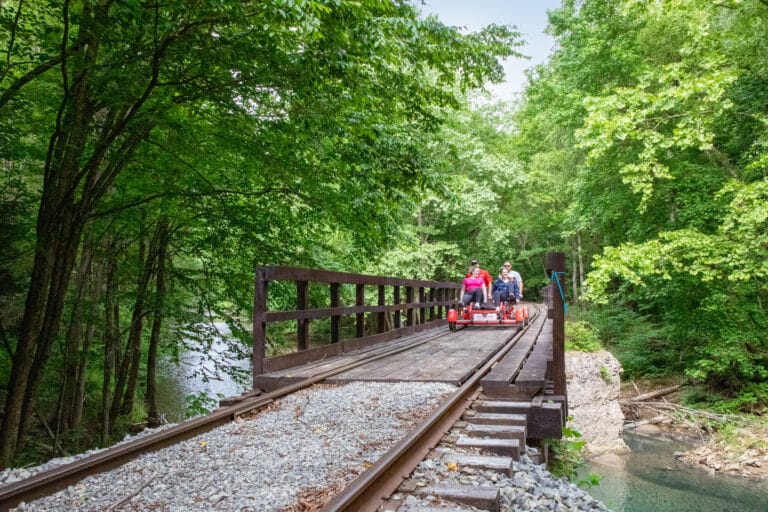by Jedd Ferris
The New Face of an Appalachian Tradition
I recently went to a wedding in North Carolina. I was milling around the reception room nursing a piece of cake when a guy approached me, shook my hand with a bear paw grip, and said, “ I’m Uncle Jim. How ‘bout some peach moonshine?”
I certainly didn’t want to offend the burly Uncle Jim (I’ve changed his name to avoid sending a friend’s relative to the pokey), so I accepted the mason jar. I took a bold swig and immediately felt like someone had taken a flamethrower to my esophagus. But after a minute of recovery I also felt a proud sense of initiation. It was my first bolt of white lightning—an Appalachian rite of passage that came to these hills with the foundation of America.
With a few more numbing pulls, the hooch started to go down smooth, and within minutes I was crocked. After making an ass of myself on the dance floor and later passing out in my suit, I woke up the next day with a headache from hell. Through a hangover haze I started to wonder about the current existence of moonshine in the mountains. Is this a dying tradition hanging on with the memory of aging rebellious hillbillies, or is it still a vital part of Southern culture?
——————–
LOOKING BACK
The tradition of making whiskey came with the first American settlers, and the taxation of home-made liquor became a central debate among our Founding Fathers. Secretary of the Treasury Alexander Hamilton—who was later famously killed by political rival Aaron Burr—taxed booze in the late 1700s to help pay for the Revolutionary War. For the next century, political leaders and small agrarian clans clashed over moonshine. Government-appointed tax collectors became notoriously feared figures, liable to come charging over the mountain at any moment to raid an established still. This battle only became more complicated in 1920 with the passing of the National Prohibition Enforcement Act. Moonshiners had more to lose during Prohibition, but also more to gain as booze became a hot commodity on underground markets. Industrial stills started popping up in big cities to meet the high demand. Then came the Great Depression, and shine was still right there serving its purpose. As author Matthew Rowley put it in last year’s book, Moonshine!, “Moonshining at home allowed tens of thousands of newly poor Americans to feed their families.”
After the 1933 repeal of Prohibition, most people assumed that stills would run dry with the increased commercialization of liquor, but recent events have revealed that bootlegged firewater is still flowing in them ‘thar hills.
——————–
STILL BOOTLEGGIN’
The days of the cops and robbers-style shootouts between tax collectors and bootleggers may be a thing of the past, but moonshine is still alive and well in Appalachia. On March 13 Marvin “Popcorn” Sutton was arrested after authorities seized 850 gallons of moonshine and three large stills with capacities up to 1,000 gallons on his Tennessee farm. A legendary bootlegger in Appalachia, Sutton makes what’s reputed to be the best shine in the South. The scrawny, bearded backwoods bandit, who chain-smokes unfiltered cigarettes, has never been one to keep his craft a secret. He was featured in a Country Music Channel documentary called Most Shocking Moonshine Madness, and he also penned a book, Me and My Likker. He even posted a homemade two-part instructional video on YouTube, explaining the process of making moonshine.
Two weeks after Sutton’s arrest, authorities dismantled a working still in the woods near Cane Creek in Walker County, Ga. No one was arrested and a local news story made it seem like police officers weren’t too concerned about finding the persons who set up the operation. Sutton was not so lucky. With three prior moonshine arrests dating back to 1974, he became the subject of an undercover investigation of the Tennessee Alcoholic Beverage Commission. After a handful of meetings with an officer posing as a potential purchaser, he ultimately led authorities right to his home distillery. A few weeks after his arrest, he was released on $20,000 bond and pleaded guilty to the charge of manufacturing, processing, and selling untaxed whiskey. He will be sentenced on August 4 and could pay up to $250,000 and face up to five years in prison for the liquor charge. Add 10 years for an additional gun charge, and the 61-year-old Sutton could end up spending the rest of his life behind bars.
“Moonshine is romanticized in folklore and the movies,” ATF Special Agent James Cavanaugh of the Nashville Field Division said in a statement that announced Sutton’s arrest. “The truth, though, is that moonshine is a dangerous health issue and breeds other crime. This has not changed over the years. The illegal moonshine business is fraud on taxpayers in Tennessee and across the country.”
Soon after Sutton’s arrest, a “Free Popcorn” movement hit the regional blogosphere. On his blog self-proclaimed renegade Christian thinker Christopher Knight from North Carolina wrote, “The federal government and too much of modern law enforcement is corrupt to the core and ‘breeds crime’ already: who the hell are these people to tell us that a guy like Popcorn Sutton is a threat to public safety?”
In an age when thousands of everyday Americans are brewing their own beer, many people are asking why making moonshine is still illegal. Especially when law enforcement is busy taking on the country’s widespread meth epidemic, going after some good ol’ boys making liquor seems like a waste of resources. But the simple reason for the effort goes back to the issue’s roots: money. The government’s tax on liquor is much higher than that of beer and wine. Uncle Sam gets $2.14 on a 750 milliliter bottle of liquor, as opposed to only $.21 for the same amount of wine, and $.05 for a 12-ounce can of beer. Making your own beer and wine was in fact illegal until 1978 when Congress passed a bill allowing the production of 200 gallons per calendar year if there are two or more adults residing in the household.
Law enforcement officers rightfully point out a serious public safety issue in making moonshine. Some of the parts used for moonshine stills, including car radiators in shoddier operations, can release toxic heavy metals into the alcohol. One study found that half of moonshine drinkers have an unsafe amount of lead in their systems. The presence of methanol in some shine has been known to cause blindness. An old-timey method tested moonshine quality with a flame from a lighter—a blue flame above a tablespoon of ignited shine meant it was safe, while a red or yellow flame meant it was distilled with impurities. As shiners often quote, “Lead burns red and makes you dead.”
Ten years ago Mike Cawthon, special agent in charge of the Nashville District of the Tennessee ABC, caught a shiner selling liquor that was almost completely lead based. “He was half brain dead, and he was also using the stuff to fuel his car,” Cawthon says. “You really don’t know what you’re getting.”
But authorities admit that bootlegging moonshine is not a high-priority crime. According to Cawthon, there was no intentional sting operation against Sutton. One of his agents just happened to run into Sutton at a gas station, and the old moonshiner offered him hooch in casual conversation. If Sutton had been more careful, he would not be in legal trouble.
“He just started talking to us and offering us quantity,” Cawthon says. “We had to go after him, and he fell for it hook, line, and sinker. He was arrogant. It’s against the law, and if we get reports on it, we have to follow up.”
——————–
UNDERGROUND ECONOMICS
Cawthon calls the Sutton bust “once in a lifetime.” Authorities in Tennessee find three or four stills a year, and none of them are anywhere near the size of Sutton’s operation. Widespread bootlegging ended in the 1960s when there was a spike in the cost of sugar. A lot of farmers turned to growing marijuana because it was easier and more profitable. “Moonshining today is a dying art,” Cawthon says. “It’s labor-intensive, and young kids do not want to work that hard.”
But he admits there is still a demand for shine if someone out there is willing to expend the effort required to make it. In addition to yeast, malt, water, and heat, the key ingredient used to make liquor these days is sugar. At least 800-pounds of sugar, which costs over $400, is required for a typical still. The ingredients are mixed until the yeast turns the sugar into alcohol. It is then boiled and mixed in another barrel to adjust the proof, which usually comes in at around 50 to 100 percent alcohol. The process, which takes between five and nine days, usually yields around 96 gallons. Six gallons, or a case lot, of bootlegged shine sells for $90-100. The price would more than quadruple if standard duty rates were applied.
——————–
GOING LEGAL
When you walk into the small barn on the property of Belmont Farms Distillery in the rural outskirts of Culpeper, Va., you can smell the boiling mash. Here Chuck Miller makes his own brand of moonshine called Virginia Lightning—legally. There’s nothing wrong with making corn whiskey in the old-time way, as long as the government gets its piece of the pie. So 21 years ago, Miller filled out the necessary paper work and purchased a 2,000-gallon copper pot still that was confiscated by authorities in an abandoned barn. Miller grows all of the corn for his brand of shine right on his 125-acre farm with a special Alcoholic Beverage Control state license. Miller’s late grandfather raised 11 children solely on the profits of making good old mountain dew, and now the backwoods family recipe is being sold in liquor stores across the country and even in Japan. City folk have particularly taken a liking to the homegrown liquor. “I wanted to carry on the family tradition,” says Miller. “But I didn’t want to run from the law. All you have to do is pay the tax, even if the government gets most of the profit.”
Although he was the first, Miller is now not the only shiner to get in on the commercial action. Last year NASCAR legend Junior Johnson teamed up with North Carolina-based Piedmont Distillers to release a new brand of shine called Midnight Moon. Before he was winning races in the 50s and 60s, Johnson was a moonshine runner for his father out of Wilkesboro, N.C. Moonshine is given prominent credit in the origins of stock car racing, and as Johnson gained a reputation for being able to foil the law with his driving skills, he would eventually become one of the pioneers of the sport. Now his fame has brought him full circle back into slinging booze.
——————–
SHINE ON
After the convenience of grabbing a bottle of Miller’s Virginia Lightning for 15 bucks, I was curious how hard it would be to score my own jar of underground shine. It turns out it took all of two phone calls. A friend of a friend of a friend in western Virginia had a line with some old time boys, and a quart-size jar could be mine for a mere 10 dollars. They declined to speak on the record, but they did make one thing clear: the bootlegging tradition will continue as long as the moon rises in Appalachia.
——————–
Read the Label – Moonshine has been given more than a few nicknames over the years.
White Lightning
Corn Liquor
Fire Water
Mountain Dew
Hooch
Cool Water
Hillbilly Pop
Tiger Sweat
Bush Whiskey
Rotgut
Panther’s Breath
Skull Cracker
Alley Bourbon







